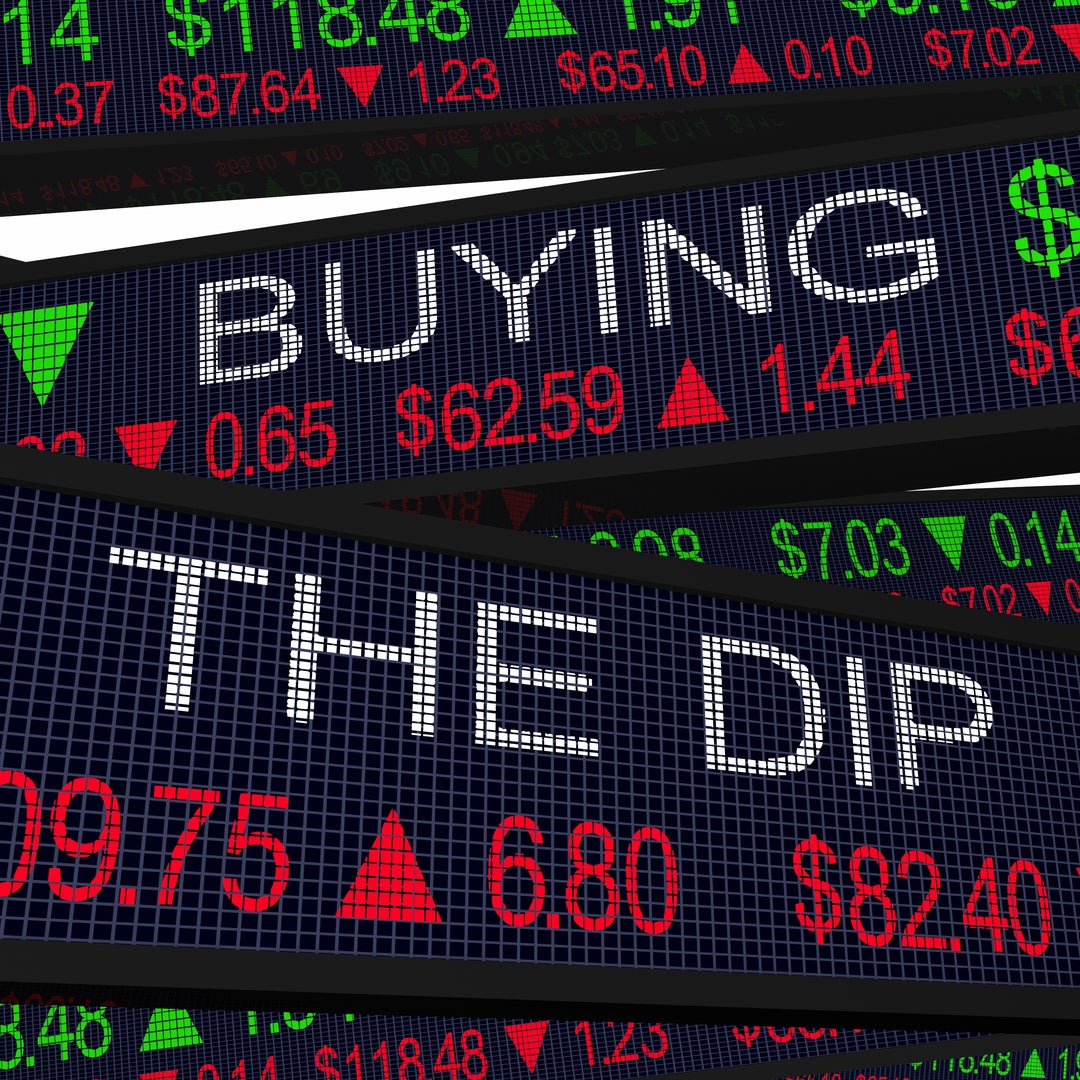Buy the Dip: What Is It & Should You Do It?

As an investor, it's important to find a good balance between the risk you're taking on and the potential returns an investment can provide. “Buying the dip” is one strategy that you can use to take advantage of ups and downs in stock prices.
So what does it mean to buy the dip, and is it the right move for you? Here's what you need to know.
What does it mean to buy the dip?
Buying the dip involves buying a stock when its price drops from a recent peak. The goal is that the recent price decline is temporary, and the investor will be rewarded when (and if) the stock price goes up again.
In other words, investors who try to buy the dip are trying to time the market as a way to beat the market.
The stock in question can be one that you don't already own, but it's also common for investors who already own shares in a company to buy the dip to increase their holdings while also reducing their average cost per share.
Buying the dip vs. dollar-cost averaging
Dollar-cost averaging (DCA) and buying the dip are both investing strategies that stock market investors can use to potentially reduce their average cost per share. But there's a key difference between the two.
DCA doesn't involve trying to time the market and take advantage of short-term price ups and downs. Instead, you use DCA by buying a specific amount of a stock in regular intervals, say $100 per month, regardless of the price. As investors use this strategy, their average cost per share can decrease naturally with normal market volatility.
You can build a DCA investing strategy with Acorns by setting or boosting your Recurring Investment.
Is buying the dip a good strategy for long-term investors?
When done properly, buying the dip could be beneficial as part of a long-term investment strategy. Reducing the cost basis of your holding — the average price you’ve paid per share you own — can help you increase your profits if you eventually sell and realize the gain.
Long-term investors may also find buying the dip appealing because they don't have to worry as much about the potential short-term consequences if a stock price doesn't rebound quickly or if it continues to slide.
But buying the dip could be just a part of your overall approach to your portfolio. You can combine this strategy with DCA, buying index funds, and other approaches to keep up a diversified investment portfolio while also trying to beat or keep up with the major stock indexes, like the S&P 500 and the Dow Jones Industrial Average.
How to buy the dip
If you're considering this strategy with your investment portfolio, here’s how to get started.
-
Have cash on hand in your brokerage account. When the opportunity comes up and you're ready, you can make your trade without needing to sell off other positions or wait for funds to settle.
-
Set a threshold. Because it's impossible to predict exactly how and when a stock price will change, it's a good idea for an investor who’s buying the dip to set a threshold for themselves for when they'll take advantage of a price decline and save up some money until that happens. This can help you avoid making impulsive trades based on emotions or biases.
-
Do your homework on the stock you're looking to buy. Make sure you understand the reason for the price decline and what experts and analysts are saying about its future. While the stock market typically rebounds after short-term declines, that's not always true for individual stocks. Even if the stock price does rebound, there's no guarantee that it'll reach previous highs again. But if a stock has strong underlying fundamentals, it could be a good target.
Example of buying the dip
Let's say you own 10 shares of ABC Company that you bought at $9.50 per share, and you plan to hold on to this investment for the long term. The stock's price recently reached a peak of $10 per share, and your threshold is 20%, which means that you'll only buy more shares once the price reaches $8 per share.
A few weeks later, the price meets your threshold, and you use some of the cash you've built up in your brokerage account to buy 10 more shares. Now, your cost basis for the 20 shares you own is $8.75.
Once the trade is completed, you'll wait until the stock price hits a new peak, and you'll start the process all over again.
How to manage risk when you buy the dip
When an investor buys the dip without a set strategy, it can open them up to the risks of short-term volatility.
If you're buying and selling shares to try to take advantage of small price dips, it may be more difficult to achieve your goal, and you'll also have to deal with short-term capital gains tax rates instead of long-term capital gains tax rates.
Having a set threshold can help you manage your risk, but it's also important to:
-
Avoid the temptation to wait for the price to decline past your threshold.
-
Do your research on the stocks you're targeting to try to figure out whether it's on a long-term trend downwards or upwards.
-
Maintain a diversified portfolio, so that if one of your positions doesn't work out the way you planned, it doesn't have too much of an impact on your overall portfolio.
-
Avoid holding onto too much cash waiting until the next dip.
The takeaway: Should you buy the dip?
If you have a diversified portfolio and you've been investing long enough that you feel comfortable making objective decisions with your brokerage account, buying the dip could be a beneficial part of your overall investment strategy.
However, if you're relatively new to investing and have a low-risk tolerance, or you tend to make emotional investment decisions, buying the dip may not be the right approach for you.
Either way, this approach to investing is best used in conjunction with other strategies that can help you diversify your portfolio and manage your risks.
This material has been presented for informational and educational purposes only. The views expressed in the articles above are generalized and may not be appropriate for all investors. The information contained in this article should not be construed as, and may not be used in connection with, an offer to sell, or a solicitation of an offer to buy or hold, an interest in any security or investment product. There is no guarantee that past performance will recur or result in a positive outcome. Carefully consider your financial situation, including investment objective, time horizon, risk tolerance, and fees prior to making any investment decisions. No level of diversification or asset allocation can ensure profits or guarantee against losses. Article contributors are not affiliated with Acorns Advisers, LLC. and do not provide investment advice to Acorns’ clients. Acorns is not engaged in rendering tax, legal or accounting advice. Please consult a qualified professional for this type of service.









